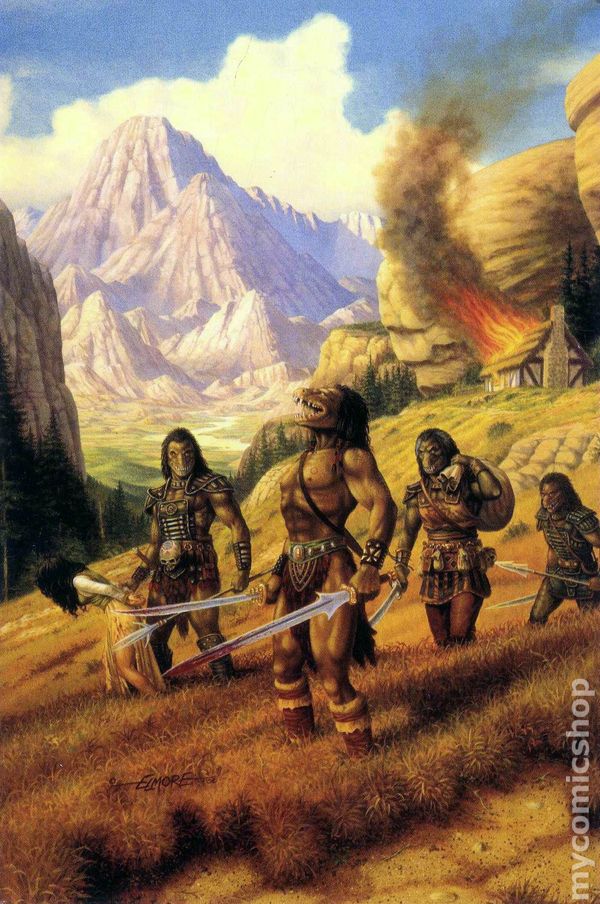
<nice image, but find a new one!>

<nice image, but find a new one!>
Climate/Terrain: Tropical and sub-tropical forest
Frequency: Very rare
Organization: Tribal
Active Times: Day
Diet: Omnivore
Intelligence: Average (8-10)
Treasure: K,Q
Alignment: Neutral (good tendencies)
Reaction Modifier: + 2
Number Appearing: 4-24 (40-60)
Armor Class: 8
Movement: 12”
Hit Dice: 2
THACO 16
Number of Attacks: 1 weapon
Damage per Attack 1-8
Special Attacks: Nil
Special Defenses: Camouflage
Magic Resistance: 80%
Size: Medium (5 feet tall)
Morale: Steady (13)
Experience value: 30 + 2/hp
Beastmen are primitive jungle<rainforest?>-dwelling humanoids, living
through hunting and gathering.
Physical Appearance: Beastmen are humanoid,
slightly shorter (about 5 feet) and slimmer than average
humans. They’re covered from head to toe with a soft green
pelt. Beneath the green fur is a shorter black undercoat. By
consciously contracting and relaxing muscles under the
skin, beastmen can cause the green fur to ripple, showing
the black beneath. Thus, when they choose (for example,
when they’re hunting), they can camouflage themselves
with rippling patterns of green and black, like the shadows
of moving leaves. This natural camouflage ability makes
them almost invisible in the forests. They surprise
opponents
on a roll of 1-4, and are effectively 90% concealed at
ranges in excess of 30 feet in wooded areas. They’re well
adapted to arboreal life. Their toes are long, to aid with
climbing, but not sufficiently so to allow the beastmen to
hang from their feet. Their faces are very human-looking
(apart from the covering of green fur). Beastmen rarely
wear clothing or ornamentation of any kind.
Combat: Beastmen aren’t aggressive creatures; they
only attack when threatened. If they’re forced into combat,
however, their natural camouflage and magic resistance
makes them daunting adversaries. They’re typically armed
with primitive spears, stone-head axes,
blowguns, and bolas,
which they use to great effect from concealment. Blowgun
darts are usually tipped with weak poison (save at +4). They
also use large weighted nets, woven from creepers, which
they drop from above to capture enemies alive. If the tribe
judges that it’s safe to do so, prisoners are disarmed and set
free (albeit some distance from the tribe’s village, and sometimes
in hazardous terrain). Prisoners judged to be a threat
even if disarmed, are killed painlessly.
Most encounters with beastmen are with hunting parties
collecting food for the tribe. If the beastmen gain surprise,
they typically shadow the intruders, only attacking if they
deem it necessary.
Habitat/Society: Although they may be judged as
primitive by many measures (and their common name
reinforces this widely-held opinion), Amedio
Jungle beastmen
are by no means unintelligent, and their social organization
might profitably be copied by many races. Beastmen
are tribal, with a single tribe comprised of up to 60 individuals.
The central figure of the tribe is the “chief,” although
this term might be misleading. The chief doesn’t seek the
position, and isn’t elected or otherwise chosen by the tribe.
When decisions have to be made, or when the tribe has to
be led, some individual leads. This individual is always the
best for the job at hand, and always has the support of the
tribe, but just who acts as chief can vary from day to day,
depending on the current circumstances.
The selection process isn’t random-if an individual tries
to lead but isn’t supported by of the tribe, the self-chosen
leader is ignored. This vague “non-structured structure”
works for the beastmen because every member of the tribe
is involved in every decision. For outsiders, however, its
fluidity often makes discussion and diplomacy with the
tribe difficult (the response to the request “take me to your
leader” will depend on the context).
Beastmen are totally egalitarian with regard to sex. The
only time females don’t participate in all facets of tribal
life is when they’re pregnant and very close to term. Beastmen
offspring are raised by the tribe as a whole; in any particular
tribe, typically 10% are immature (10-80% grown).
Young aren’t involved in hunting and gathering-although
they show camouflage ability from birth-until they reach
maturity at the age of 10 years. Beastmen live to be about
50 years old. Elderly members of the tribe are cared for in
the same way as children, and typically make up 5% of any
tribe.
Beastman tribes dwell in the trees, in shelters cunningly
woven from growing branches. Each dwelling houses one
family (3-4 adults of both sexes in a loose group marriage,
plus children).
Unlike most other “primitives,” beastmen have no religion
whatsoever. They don’t believe in gods, spirits, ghosts,
magic or anything supernatural: If they can’t touch and
measure it, it doesn’t exist. Thus they have no tribal shamans
or witch doctors. It’s not known whether this philosophy
arose because of the creatures’ resistance to magic, or
whether it’s somehow a cause of this resistance.
Beastman tribes tend to keep to themselves, communicating
only with other beastman tribes. They use and produce
few artifacts, and hence have little interest in trade.
They speak their own language, but a few individuals can
converse haltingly in the common tongue. The bulk of their
population seems to be in the Amedio Jungle, although
there are reputed to be beastmen tribes in the jungles of
Hepmonaland as well.
Niche: Beastmen are at the top of the food
chain. They
hunt smaller forest-dwelling animals, and gather edible
vegetation. They have no interest in any form of agriculture
or animal husbandry. They are hunted-often with
limited success, thanks to their intelligence-by large jungle
carnivores. They manufacture very little-usually just
weapons and rudimentary tools-and have almost no interest
in luxury items. Their civilization, such as it is, is self-sustaining,
and they have no dependence on trade with
anyone else (this doesn’t mean that they won’t consider
trade in special circumstances, however).